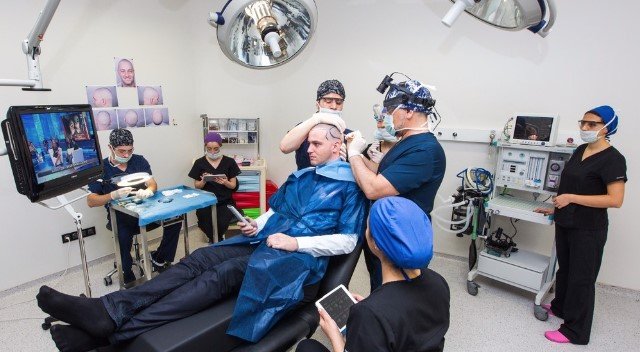Hair transplant in Pakistan: Thanks to one significant development, outcomes today can seem natural. Most doctors now only transplant a few healthy hairs at a time. In contrast to the 1970s and 1980s, patients no longer encounter the synthetic doll-like hair that was common at the time. Hair plugs, which were once used to conceal bald spots, were common. Eventually, the hair plugs were very noticeable.
Results that appear more natural can also be achieved by enhancing the hairline and strategically placing hairs in areas where they are thinning.
These advancements have made it possible for the outcomes to seem so natural that a barber or stylist would not even realize you had any treatment done.
Hair transplant in Pakistan
A hair transplant will be performed by a dermatologist or plastic surgeon to cover bald spots on the head. The surgeon often transfers hair from the top of the head or the front of the head to the side or the rear. A local anesthetic is usually used when having a hair transplant at a doctor’s office.
First, we look into the main causes of hair loss/hair baldness.
Causes for hair loss/hair baldness
Mostly pattern baldness can be a reason for hair loss. Genetics is what it comes down to. The remaining instances result from a variety of reasons, such as:
- Genetics
- Immune System
- Stress or Shock
- Drugs for Medical Issues
Genetics
Exactly how it’s inherited is not clear, but it does tend to run in families. So if you have close relations who are balding, you are more likely to have it, too.
Doctors don’t completely understand why certain hormonal changes bring on hair follicles to shrink, or why the balding process gradationally happens in the same pattern for utmost men. But it generally starts with a thinning of the hairline above your tabernacles and crown.
Lahore Postal Code List: Lahore Zip Code
Depending on your family history, male pattern baldness can start as prematurely as your teens. Not only will your hair get thinner, but it may also get softer, fine, and shorter. Learn further about the ways you can take to help head off going bald if you spot the warning signs early enough.
Immune System
However, you may have an inheritable condition called alopecia to aerate, If you have abrupt hair loss that leaves round bald spots about the size of a quarter in varied places on your head. It frequently begins in youth. You’re more likely to have it if a close family member has it.
Your body’s immune system attacks your hair follicles, causing small patches of hair to fall out. There’s no pain or sickness involved, and it’s not contagious. Your hair may grow back, but it may fall out again, too.
Stress or Shock
It is the most common cause of hair loss. Unexpected or extreme weight loss, a severe physical or emotional shock, surgery, or indeed fever and the flu can bring hair loss that could last several months.
Medical Issues
Temporary hair loss can be a sign of a medical issue, like anemia or thyroid problems. A diet low in protein and iron can also make your hair to thin.
Your trouble for hair loss is high if you have diabetes or lupus.
Hair loss could be a side effect of certain medicines you take for
The procedure of a hair transplant In Pakistan.
Step 1: Consultation
Consultation is the initial step in receiving a hair transplant. One of our patient advisers, who is extremely knowledgeable about the treatment and can answer many of your concerns, maybe your initial point of contact during your consultation. Before scheduling your treatment, you must schedule a consultation with one of our hair transplant doctors. Before doctors can analyze your hair and determine whether you are a good candidate for a hair transplant, this provides you the chance to talk about your hair loss and go over your medical history.
Step 2: Getting ready the scalp
You might need to shave as the day of your treatment draws near. Others may wait until the day and have this done at the clinic, while some people want to do this gradually in the months before their procedure. Your hair transplant surgeon can limit transaction rates and imitate the natural angle and direction of native hairs by shaving your head.
Step 3: Prior Checkup
When you arrive at the clinic for your hair transplant, you will need to fill out some documentation consenting to the treatment. The nurses helping with the process at the clinic will explain everything to you. Additionally, the clinic will take pre-op photos of you, which they will keep on file. The surgical processes will then be repeated with you, the treatment locations will be indicated, and the surgeon will address any concerns you may have.
Step 4: Anesthetic
To make the extraction and grafting of the hair painless and comfortable for the patient, a local anesthetic will be given to the scalp before the treatment. This phase could hurt at first, but many patients are amazed by how quickly it works and how quickly the effects appear. Because you will be cognizant during the whole treatment, you can let the doctor know if you ever feel uncomfortable or need a break.
Step 5: Extraction of Follicular Units
The first step in a hair transplant procedure is extraction, which involves puncturing the skin around the hair follicle 1-2 millimeters below the surface with a specialized punch device that ranges in diameter from 0.6mm to 0.9mm. The hair follicle bulb is then removed using fine forceps with the help of a strong magnifying glass to ensure accuracy. The hair follicle bulb is then put into a glass tray and maintained in a solution to keep it at the ideal humidity, temperature, and hydration levels until the extraction procedure is finished.
Step 6: Taking the Grafts Out
Following the completion of the extraction process, you will often be given a break for lunch during which you can walk about and eat.
Your surgeon will begin examining the retrieved grafts at this point and deciding which ones are appropriate for usage and which ones are not. After that, they are divided into groups according to the thickness, bulb size, and quantity of hairs to ensure that there is sufficient diversity to provide the patient with the most realistic-looking outcome.
Step 7: The grafts are implanted
You’ll be prepared for the implant stage once your surgeon has chosen all the grafts. If you want to make sure the treatment is still painless and pleasant, you might need to have your local anesthetic topped off at this point. Your hair transplant surgeon will next individually implant each follicle into the recipient region of the scalp. The implanter tool will insert into the intradermal layer of the scalp the hair follicle bulb after first penetrating the skin.
Step 8: Final result
The hair removed from your donor location is known to be resistant to male pattern baldness, therefore a hair transplant is made to endure for decades. However, it’s crucial to keep in mind that other parts of your scalp that weren’t treated may still be susceptible to male pattern baldness; as a consequence, over time, thinning and baldness may develop in these parts, necessitating a second hair transplant treatment. To guarantee that your results are long-lasting, The Private Clinic’s highly skilled surgeons will take care to anticipate any potential future hair loss trends.
https://travelsdomain.com/10-best-ladies-gym-in-islamabad/
https://travelsdomain.com/top-11-best-gyms-in-karachi-top-fitness-centers-in-karachi-2/
Benefits of hair transplant
Getting a hair transplant can boost your confidence and looks. Suitable people for hair transplants include:
- Male pattern baldness sufferers
- Anyone with a burn or scalp injury
- Especially ladies with thinning hair
Side effects of hair transplant
Although a hair transplant is mostly a safe treatment, there is always a little chance of:
An allergic response to the anesthetic bleeding infection
Your surgeon should swiftly resolve these issues.
There is a slight possibility that the transplant could fail and the hair will fall out or leave a visible scar.
Your surgeon should go through the likelihood of these issues and the recommended course of action.
In the area of the transplant, your hair may continue to thin. To ensure that the hair looks natural over time, your surgeon should carefully consider the layout of the transplant.
Cost of hair transplant in Pakistan
The costs of hair transplants in Pakistan depend on various factors. It ranges between 50,000 and 400,000 rupees depending upon which center you choose for your hair transplant in Pakistan; how many hairs are transplanted; which doctor is performing the surgery; and which method of surgery is used. The Cost of 5000 Hair Grafts in Islamabad Pakistan ranges from 150,000 to 250,000 PKR depending upon the extent of baldness.
Best Hair transplant centers in Pakistan
1-Excellence Hair Transplant Center Islamabad
Address: Old Airport Rd, Fazal Town Phase I Phase 1, Rawalpindi, Punjab, Pakistan Old Airport Road، Fazal Town Phase I,
Rawalpindi, Islamabad, Rawalpindi, Punjab 46000
Phone: 0303 5888835
2-Abdul Khaliq’s hair transplant in Islamabad
Located in: Khayal Plaza
Address: 2nd Floor Khayal Plaza, Islamabad, 44220
Phone: 0334 5167977
3-Glamorous Clinic
Glamorous Hair Transplant Clinic Islamabad; Address, Parkland City Centre, Office No 32,
1st Floor, I-8 Markaz Islamabad, Pakistan ; Phone, +92 333 5705871
4-Hair Club Pakistan
Islamabad Clinic 1
Suite # 17, Top Floor, Beverly Centre, Blue Area
OUR PHONE:
+92-51-2873666
+92-51-2873667
+92-309-2227-424
Lahore
Lahore Clinic 1
46-A FCC, Zahoor Elahi Road, Gulberg II (Opposite F.C College)
OUR PHONE:
+92-42-35772500
+92-42-35772501
+92-345-8554-424
5-JJ Aesthetics – hair transplant, Skin & Plastic Surgery Clinic in Islamabad and Rawalpindi
Address: JJ Aesthetics Rajpoot Street Block E, Satellite Town Opposite Gate, 2 Holy Family Rd, Rawalpindi, 46000
Phone: 0303 8211019
6-Hair Plus hair transplant center
Address: 2nd Floor Nazir Plaza Chandni Chowk, Main Murree Rd, Asghar Mall Scheme, Rawalpindi, Punjab
Phone: 0300 5029677
7-Unshaved FUE hair transplant Surgeon in Islamabad – Dr. Muhammad Salman Khan
Address: Office 20, Beverly Centre, F 6/1 Blue Area, Islamabad, Islamabad Capital Territory 44000
Confirmed by this business 3 weeks ago
Phone: 0306 5577753
8-Amna’s Skin and Aesthetics Clinic
Dr.Amna’s Skin and Cosmetic clinic. is located at Service Plaza, Shop 1, 2 Mall Rd, Saddar, Rawalpindi, Punjab 46000, Pakistan,
9-Dr Habib’s hair transplant in Peshawar
Dr. Habib Ullah Shah MBBS.MCPS. FCPS(Plastic & Cosmetic Surgery)
office 201 A city tower University Road Peshawar, Peshawar, Pakistan+92 311 8800339
10-Dr. Asad Toor hair transplant clinic
Hair transplantation clinic in Lahore
Address: 42-A, Block, B-II Ghalib Rd, Ghalib Market Gulberg III, Lahore, 54000
Phone: 0322 4021313
Appointments: drasadtoor.com







